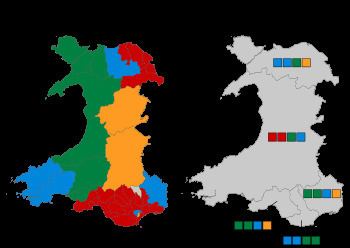3 May 2007 2011 → 30 seats 12 seats 4 3 Start date May 3, 2007 | Turnout 43.7% 5.5% 26 15 314,925 219,121 | |
 | ||
Winner Rhodri Morgan | ||
The 2007 National Assembly election was held on Thursday 3 May 2007 to elect members to the National Assembly for Wales. It was the third general election. On the same day local elections in England and Scotland, and the Scottish Parliament election took place. This election was preceded by the previous Assembly election in 2003.
Contents
- Major parties
- Electoral method
- Pre election forecasts
- Electoral results
- Constituency nominations
- Mid and West Wales
- North Wales
- South Wales Central
- South Wales East
- South Wales West
- New members
- Defeated members
- Retiring members
- National election 2003
- References
The election saw Plaid Cymru make gains at the expense of Labour, although Labour remain the largest party in the Assembly, as they have since it began. Plaid stated they would make a referendum on devolving further powers to the National Assembly a condition for a coalition. Wales reported that senior civil servants before the election were preparing for three possible coalition administrations: Labour/Liberal Democrat, Labour/Plaid Cymru or Plaid Cymru/Liberal Democrat/Conservative.
Discussions between Plaid Cymru, the Conservatives and the Liberal Democrats to form a "Rainbow" Coalition broke down, and a coalition was eventually agreed between Labour and Plaid Cymru.
Major parties
The Welsh Labour Party before the election had 29 seats, Plaid Cymru had 12, the Welsh Conservative Party 11, the Welsh Liberal Democrats 6, Forward Wales 1, with 1 independent (Trish Law). Mrs Law won her seat at a 2006 by-election, the seat having been won by Labour in the 2003 election. The one Forward Wales Assembly Member was elected as an independent before forming the party. Otherwise, the standings represent the 2003 results.
Electoral method
In general elections for the National Assembly for Wales, each voter has two votes in a mixed member system. The first vote may be used to vote for a candidate to become the Assembly Member for the voter's constituency, elected by the first past the post system. The second vote may be used to vote for a regional closed party list of candidates. Additional member seats are allocated from the lists by the d'Hondt method, with constituency results being taken into account in the allocation. The overall result is approximately proportional.
Pre-election forecasts
Predictions for the seat distribution were made by a number of polls before the election:
Electoral results
(source:)
Constituency nominations
NB: candidates in BOLD text were incumbent assembly members before the election
Mid and West Wales
North Wales
South Wales Central
South Wales East
South Wales West
In South Wales West, there are also party lists from the Communist Party of Britain, Christian People's Alliance, RESPECT, Socialist Labour Party, Welsh Christian Party and two independents (Keith James and John Hudson Jenkins).
New members
Thirteen of the members elected to the Assembly in the election were not members of the previous Assembly; they include Gareth Jones, who sat in the Assembly from 1999 to 2003 but lost his seat in that election.
Defeated members
Nine sitting AMs were defeated at the polls.
Retiring members
Four sitting AMs did not offer themselves for re-election.
National election, 2003
Due to boundary changes the composition of the outgoing Assembly will not reflect the Assembly that was elected in May 2003 (see National Assembly for Wales constituencies and electoral regions). The main changes are in the North west of Wales where the constituencies of Conwy, Caernarfon, and Meirionydd nant Conwy are replaced by Aberconwy, Arfon and Dwyfor Meirionnydd.
